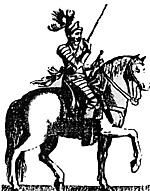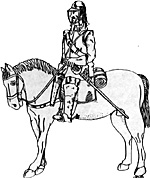 By the time of the Civil Wars, the role of the horse in battle was already beginning to change. Successive Medieval and Tudor Parliaments had carefully developed by legislature a horse which had become known as the 'Magnus Equus'- The English Black or Great Horse. By crossing imported Flemish and Hainault heavy horses with our smaller and lighter breeds a beast of noble proportions was produced. It had to be! A fully armoured knight could weigh as much as 4 Cwts., and the horse itself carried armour. It was a very active type, standing around 15 or 16 hands (about 5'6" at its shoulder); smaller than the modern show ring Shire horse and having the massivity of bone, and depth of body, more closely resembling the present day Ardennes. It was trained in the 'manege' to perform such High School movements which would effectively turn it into a weapon in its own right.-One well placed kick would often deter even the most persistent enemies!
By the time of the Civil Wars, the role of the horse in battle was already beginning to change. Successive Medieval and Tudor Parliaments had carefully developed by legislature a horse which had become known as the 'Magnus Equus'- The English Black or Great Horse. By crossing imported Flemish and Hainault heavy horses with our smaller and lighter breeds a beast of noble proportions was produced. It had to be! A fully armoured knight could weigh as much as 4 Cwts., and the horse itself carried armour. It was a very active type, standing around 15 or 16 hands (about 5'6" at its shoulder); smaller than the modern show ring Shire horse and having the massivity of bone, and depth of body, more closely resembling the present day Ardennes. It was trained in the 'manege' to perform such High School movements which would effectively turn it into a weapon in its own right.-One well placed kick would often deter even the most persistent enemies!
Strong, sturdy legs, with good 'bone' (measured round the leg just below the knee) and short cannons (shin bones) were essential to stand up to the strain of weight-bearing and the work of marching and battle. Tall, leggy horses were not only unthrifty but would have had an inherent leg weakness, useless on campaign.
As the C17th unfolded, firearms were becoming increasingly more efficient and numerous. Knowing armour to be useless against close range guns, that it was cumbersome and heavy, and that speed was on the verge of becoming fashionable, men began to discard it. With the exception of Heselrig's 'Lobster' and possibly 2 other troops of horse, most Civil War troopers desired no more than a 'Back & Breast' or even just a Buff Coat. With the overall weight lessened so too did the need for a very large horse.
Years of Peace
In the years of peace, racing and hunting had taken precedence in men's mind over the Arts of War, and fast, light horses of Eastern blood had already been imported into England to breed with existing stock. However, not everyone saw this as an improvement. Prior to the War, Sir Edward Harwood presented a Memorial to Charles I deploring the deficiency of good and stout horses for the defence of the Realm, blaming the Racing fraternity for their decline.
In 1617 Gervase Markham wrote: "I do daily find in mine experience that the virtue goodness, boldness, swifness and endurance of our own truw bred English horses is equal to any race of horse whatsoever. Some former writers...have concluded that the English horse is...fitter for the cart than either saddle or working employment. How false this is all English horsemen know. The true English horse is...of tall stature and large proportions; his head not so fine as either the Barbarie's or the Turks, yet is lean, long and well fashioned, and all his limbs large, leane, flat and excellently jointed. For their endurance I have seen them suffer and execute as much and more than every I noted of any foraine creature..."
 But though not everyone actively sought to keep the old Great Horse in his former mold, animals such as he represented were still looked upon with considerable esteem. In the early years of the War, Cromwell-himself no mean judge of horse flesh- wrote from Stilton, "I will give you 60 pieces for the Black you won at Horncastle...for my son has a mind to him."
But though not everyone actively sought to keep the old Great Horse in his former mold, animals such as he represented were still looked upon with considerable esteem. In the early years of the War, Cromwell-himself no mean judge of horse flesh- wrote from Stilton, "I will give you 60 pieces for the Black you won at Horncastle...for my son has a mind to him."
Later, in the same letter, he was offering 15-20 pieces for lighter horse (presumably cobs) on which to mount dragoons. It is fairly obvious as to which type of horse Cromwell refers to. He was a Huntingdonshire man and the black Frisian horses had been used extensively in the drainage of the Fens. They were middle size (around 15 hands), sturdy, strong and active. The often 'heavy going' of the time made them excellent for charging at 'a pretty round trot' and they were formidable against lighter animals (for example the horses used by many Scots troopers). These latter may well have scored better in the 'full-tilt' affairs but, contrary to popular belief, Civil War encounters were rarely began at break-neck speeds, and having a swift horse was not as advantageous as it may seem.
Major Lucas-Phillips cites the example of Lambert who, whilst attempting to escape after the final skirmish at Daventry in 1660 and mounted upon a fast Arab, rode into heavy plough and was overtaken by Ingoldsby's heavier horse.
Back to English Civil War Notes&Queries No. 4 Table of Contents
Back to English Civil War Times List of Issues
Back to Master Magazine List
© Copyright 1984 by Partizan Press
This article appears in MagWeb (Magazine Web) on the Internet World Wide Web.
Other military history articles and gaming articles are available at http://www.magweb.com